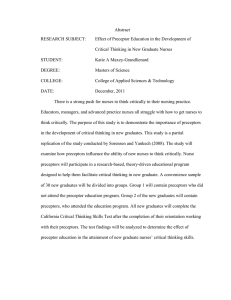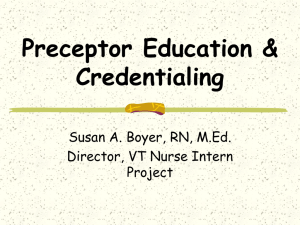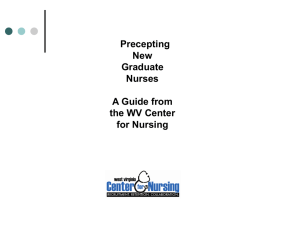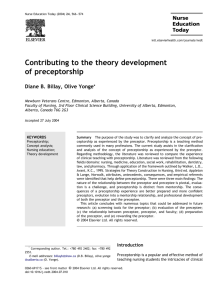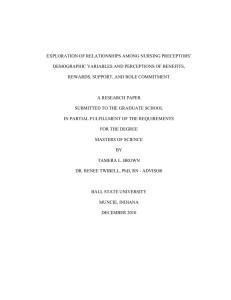Impact of orientation on recruitment, retention, and job satisfaction
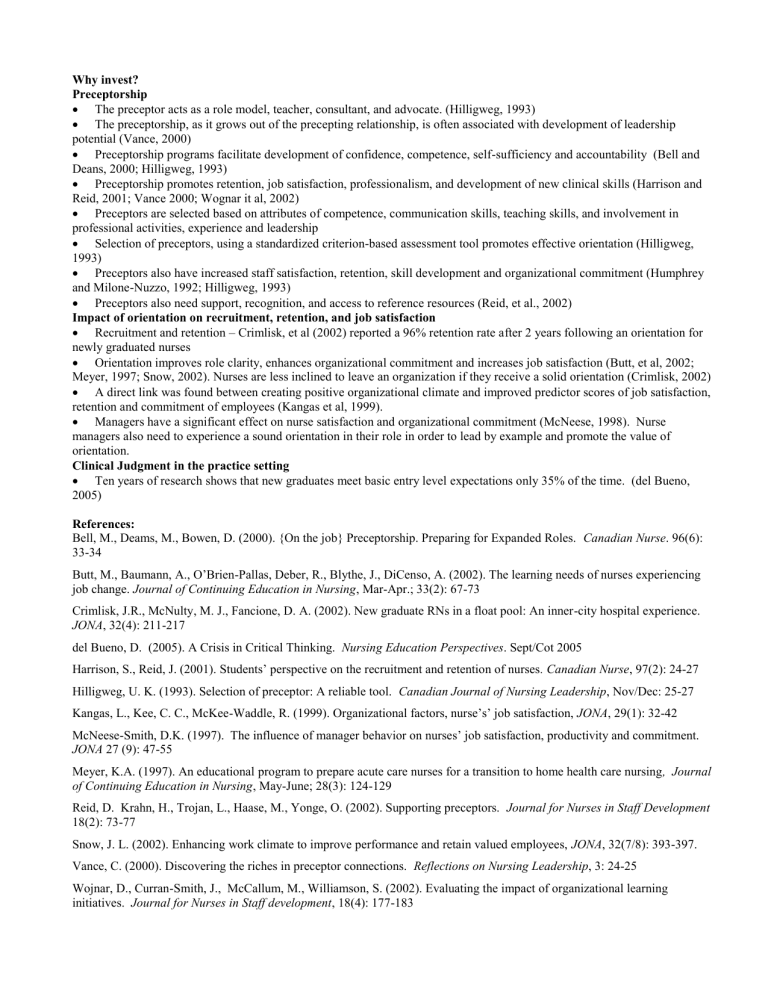
Why invest?
Preceptorship
The preceptor acts as a role model, teacher, consultant, and advocate. (Hilligweg, 1993)
The preceptorship, as it grows out of the precepting relationship, is often associated with development of leadership potential (Vance, 2000)
Preceptorship programs facilitate development of confidence, competence, self-sufficiency and accountability (Bell and
Deans, 2000; Hilligweg, 1993)
Preceptorship promotes retention, job satisfaction, professionalism, and development of new clinical skills (Harrison and
Reid, 2001; Vance 2000; Wognar it al, 2002)
Preceptors are selected based on attributes of competence, communication skills, teaching skills, and involvement in professional activities, experience and leadership
Selection of preceptors, using a standardized criterion-based assessment tool promotes effective orientation (Hilligweg,
1993)
Preceptors also have increased staff satisfaction, retention, skill development and organizational commitment (Humphrey and Milone-Nuzzo, 1992; Hilligweg, 1993)
Preceptors also need support, recognition, and access to reference resources (Reid, et al., 2002)
Impact of orientation on recruitment, retention, and job satisfaction
Recruitment and retention – Crimlisk, et al (2002) reported a 96% retention rate after 2 years following an orientation for newly graduated nurses
Orientation improves role clarity, enhances organizational commitment and increases job satisfaction (Butt, et al, 2002;
Meyer, 1997; Snow, 2002). Nurses are less inclined to leave an organization if they receive a solid orientation (Crimlisk, 2002)
A direct link was found between creating positive organizational climate and improved predictor scores of job satisfaction, retention and commitment of employees (Kangas et al, 1999).
Managers have a significant effect on nurse satisfaction and organizational commitment (McNeese, 1998). Nurse managers also need to experience a sound orientation in their role in order to lead by example and promote the value of orientation.
Clinical Judgment in the practice setting
Ten years of research shows that new graduates meet basic entry level expectations only 35% of the time. (del Bueno,
2005)
References:
Bell, M., Deams, M., Bowen, D. (2000). {On the job} Preceptorship. Preparing for Expanded Roles. Canadian Nurse . 96(6):
33-34
Butt, M., Baumann, A., O’Brien-Pallas, Deber, R., Blythe, J., DiCenso, A. (2002). The learning needs of nurses experiencing job change. Journal of Continuing Education in Nursing , Mar-Apr.; 33(2): 67-73
Crimlisk, J.R., McNulty, M. J., Fancione, D. A. (2002). New graduate RNs in a float pool: An inner-city hospital experience.
JONA , 32(4): 211-217 del Bueno, D. (2005). A Crisis in Critical Thinking. Nursing Education Perspectives . Sept/Cot 2005
Harrison, S., Reid, J. (2001). Students’ perspective on the recruitment and retention of nurses . Canadian Nurse , 97(2): 24-27
Hilligweg, U. K. (1993). Selection of preceptor: A reliable tool. Canadian Journal of Nursing Leadership , Nov/Dec: 25-27
Kangas, L., Kee, C. C., McKee-Waddle, R. (1999). Organizational factors, nurse’s’ job satisfaction, JONA , 29(1): 32-42
McNeese-Smith, D.K. (1997). The influence of manager behavior on nurses’ job satisfaction, productivity and commitment.
JONA 27 (9): 47-55
Meyer, K.A. (1997). An educational program to prepare acute care nurses for a transition to home health care nursing , Journal of Continuing Education in Nursing , May-June; 28(3): 124-129
Reid, D. Krahn, H., Trojan, L., Haase, M., Yonge, O. (2002). Supporting preceptors. Journal for Nurses in Staff Development
18(2): 73-77
Snow, J. L. (2002). Enhancing work climate to improve performance and retain valued employees, JONA , 32(7/8): 393-397.
Vance, C. (2000). Discovering the riches in preceptor connections. Reflections on Nursing Leadership , 3: 24-25
Wojnar, D., Curran-Smith, J., McCallum, M., Williamson, S. (2002). Evaluating the impact of organizational learning initiatives. Journal for Nurses in Staff development , 18(4): 177-183
